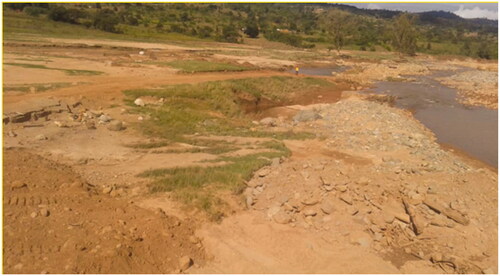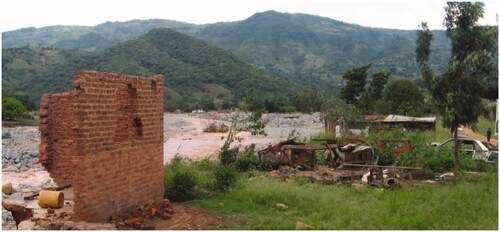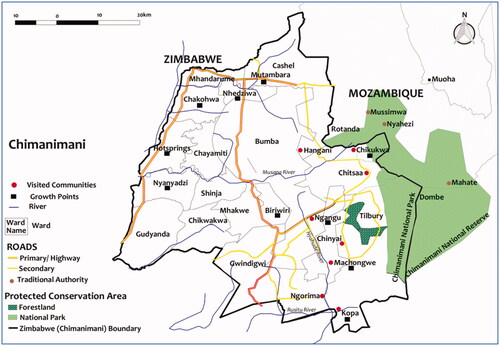Figures & data
Figure 2. ‘These are the remnants of what was formerly a hub of business and urban growth point, with homes and shop – laid to the ground by the ravage of Cyclone Idai’. The female farmer who shared this (in a photovoice narrative at the Peacock tuckshop area, near Machongwe) described how this place became desolate and filled with rock debris, with the picture hinting at how people lost homes, businesses, land for agriculture and loved ones due to the cyclone.

Figure 3. ‘I took this picture because I still cannot comprehend what happened here. Here is where I lived and did subsistence farming. My crops were destroyed and what remains is this flowing river to remind me of the water that we cried for. Taichemera n’anga ichadya mai…We wanted rain because our crops were drying and we didn’t want a drought, not knowing the coming of rains will bring us destruction. We were happy when it rained non-stop until the rain started to take our own’. (Female farmer, discussing cyclone impacts in Kopa, photovoice narrative during site visit, 2019).

Figure 4. ‘Disaster left many people in poverty without food…gardens were washed away by the floods…People are now surviving on gold panning. Nyahode River and its streams are congested with [gold] panners – both local and migrants. Red muddy water in this pool is coming upstream where mining is happening, we used to get fish from Mozambique but very few vendors are crossing to buy fish for reselling here because everyone is hesitant of crossing Haroni River due to Cyclone Idai events, therefore local men are now resorting to fishing in mining polluted waters. They are selling the fish here at the market’. (Female farmer, photovoice narrative during site visit, Nyahode River in 2020).
![Figure 4. ‘Disaster left many people in poverty without food…gardens were washed away by the floods…People are now surviving on gold panning. Nyahode River and its streams are congested with [gold] panners – both local and migrants. Red muddy water in this pool is coming upstream where mining is happening, we used to get fish from Mozambique but very few vendors are crossing to buy fish for reselling here because everyone is hesitant of crossing Haroni River due to Cyclone Idai events, therefore local men are now resorting to fishing in mining polluted waters. They are selling the fish here at the market’. (Female farmer, photovoice narrative during site visit, Nyahode River in 2020).](/cms/asset/dfd68d9d-5ecc-460d-8dd6-6cd8f9835ebc/rmob_a_2099756_f0004_c.jpg)

